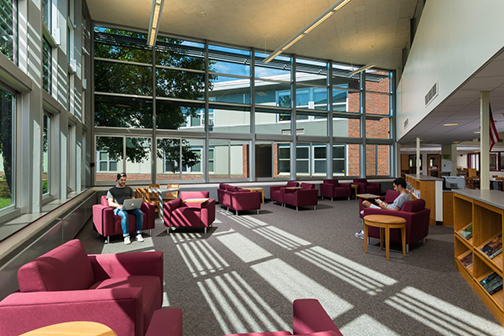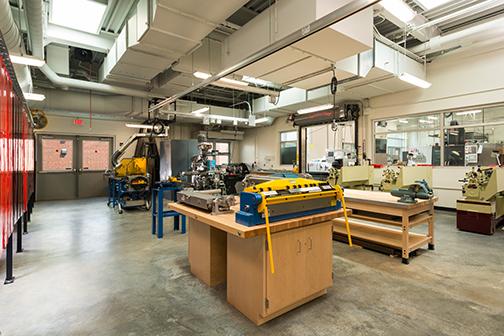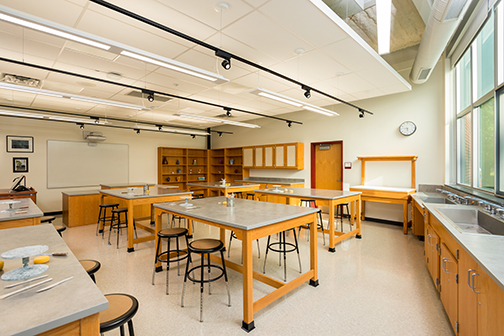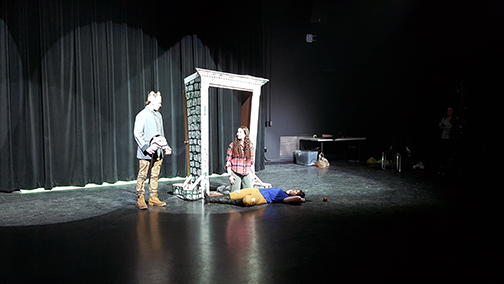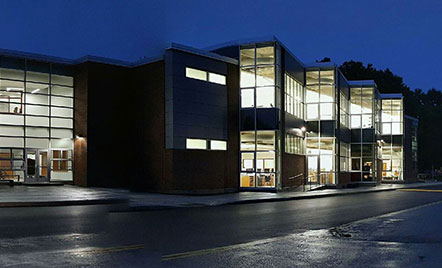
Grand Opening Ceremony draws in more than 150 people to celebrate and tour new STEAM addition
On Wednesday, Sept. 6 Superintendent Patrick McGrath along with Board members, local dignitaries, and high school students cut the maroon and white ribbons to officially mark the opening of the high school’s new state-of-the-art STEAM addition. After the speeches and ribbon cutting residents were invited to tour the facility and see all the new technology. [SNEAK PEAK VIDEO]
New state-of-the-art facility brings advanced opportunities to students, staff
Over the past several years, all BH-BL schools have undergone various upgrades and modernizations or construction as part of the 2013 voter-approved referendum. The most recently completed project is the new Science, Technology, Engineering, Arts, and Math (STEAM) addition at the high school. This is the single largest project undertaken by the district since the construction of the middle school in 1961.
The state-of-the-art facility elevates the high school and district to a whole new level by adding high-tech classrooms and labs for hands-on and interactive work in such areas as advanced manufacturing, industrial engineering, robotics, electronics, computer science, graphic design, applied math, 2-D and 3-D art, computer-aided design (CAD), and digital music.
“It’s exciting to be able to offer our students and faculty advanced technology and learning spaces that better align with the digitized world we live in,” says BH-BL High School Principal Tim Brunson. “The new facilities will help us further enhance our course offerings, introduce our students to collegiate-level technology, and put us on the map for having a cutting-edge high school of the future.”
High-tech classrooms
The new wing is home to 18 high-tech classrooms (there is also one in the library and seven at the middle school) that put the latest instructional technology at teachers’ fingertips through the use of district-designed SmartHubs. The hubs are similar in style to lecterns but include a touchscreen monitor and digital control panel to easily engage such devices as:
high-definition, interactive projectors and document cameras that allow teachers and students to edit each other’s screens across the wireless network and display objects or documents from the monitor onto a large-screen whiteboard. For example, a student could share computer code she wrote on her computer to a projector. The teacher could then annotate with an electronic pen over the image projected on the touch-enabled whiteboard; high-definition cameras for live broadcasting or lecture captures, allowing teachers to record lessons for remote broadcast or archive for homework review and studying; and video conferencing and distance learning equipment such as cameras, microphones, speakers, etc. to connect classrooms with guest speakers or take virtual field trips anywhere around the world.
The new classrooms also feature modern-day furniture that’s more suitable for today’s learning environment. The tables and chairs can easily be adjusted to accommodate different class assignments and lessons. For example, teachers who shift between collaborative and individual work might need to create a lab-style space where desktops are raised so students can stand behind them to work.
“These are just a few of the many potential conveniences that will be offered in the model classrooms,” adds Brunson. “And nearly every high school student will take at least one class in the STEAM addition and, therefore, will be able to experience and benefit from the advanced technology.”
Read more about…
- New Computer Science Studio models college, workplace settings
- High school library evolves into 21st-century Learning Commons
- New Design & Technology Center prepares students for future
- Sophisticated art classrooms support collaboration, creativity
- Black box theater expands opportunities for students, community
New Computer Science Studio models college, workplace settings
The STEAM addition also houses a Computer Science Learning Studio, which is unique to high schools in the area. Along with a SmartHub and instructional technology, the studio includes 30 high-powered, large-screen computers with industry-standard software that students will use to learn, and experiment with, coding and computer programming.
The computer science industry is projected to grow much faster than other industries over the next 10 years, according to the U.S. Bureau of Labor Statistics. And colleges and universities are reporting that more students than ever are majoring in computer science in order to pursue such careers as software engineers, web developers, computer system or security information analysts, and computer and information research scientists.
“Our Computer Science Learning Studio puts BH-BL in a position to introduce students in a more robust capacity to computer science and math applications and tools that are available in real-world settings,” says Supervisor of Mathematics William McQuay. “We offer a four-year sequence in computer science beginning with introductory principles and culminating in a capstone course in which students develop their own software solution.”
Distance learning offerings to expand at BH-BL
The Computer Science Learning Studio is also equipped with distance learning technology that will be used to broadcast computer science courses to other districts. Using a high-definition camera and dual-screen monitor, BH-BL students and teachers will connect and collaborate with students from other districts across the state. The dual screen allows students who are located in other schools to simultaneously view the content being taught and interact with the teacher and students in the studio.
Distance learning courses have been around for quite some time but were mostly popular in small, rural districts because it allowed them to offer electives they otherwise didn’t have the student population to support. As technology has become more advanced and college-level courses more attainable for high school students, distance learning courses have gained popularity among schools of all sizes. For instance, this school year BH-BL High School students can enroll in a Mandarin Chinese course because it’s supported through distance learning. The district is reimbursed a majority of the costs through tuition from the remote districts. And even more elective opportunities are on the horizon because BH-BL, along with many other districts beyond the Capital Region, is now part of the BOCES Distance Learning Network. Along with Mandarin Chinese and computer science courses, an early childhood development course will be taught by BH-BL faculty and offered to other districts within the network.
“Distance learning is a win-win for us,” says Superintendent Patrick McGrath. “It opens many new doors for our students and staff while keeping the associated costs low. It also helps us achieve our goal to expand our college-credit program, BH-BL+1, and make it possible for students to earn a full year of college credits while still in high school.”
High School Library Evolves into 21st-Century Learning Commons
Space includes modern study rooms, school store, and cafe
Libraries are reinventing themselves. They are evolving from places of silent, independent study filled with weighty tomes and archives into full-service learning, research, and project spaces.
This summer the high school library media center was expanded and restructured to become a modern learning commons with a versatile environment that supports multiple learning activities.
“It was important that we transform and modernize the school’s library to meet the evolving needs of our students and the requirements of their academic work,” explains High School Principal Tim Brunson. “The new space is modeled after elite college libraries and research centers, and it thoughtfully merges the best of the physical and digital environments.”
Learning commons bring together some of the finest features of traditional libraries, labs, lounges, and classrooms into a single space where students can work together and establish the kinds of connections that promote active, engaged learning.
The school’s new learning commons provides space for group meetings along with the technology tools needed to support creative efforts. For instance, there is now a 21st-century classroom (see p. 1) and three glass-enclosed huddle rooms where small groups of students (typically between four and 10) can work on a project, hold a study session, practice presentations, and use video conferencing software. Teachers also now have more flexibility in assigning projects that require collaboration and creative learning because of the new rooms. Furthermore, the huddle rooms include distance learning technology and, at times, will be where small groups of students take such courses, or where BH-BL faculty broadcast a course to students outside of the district.
The main area of the learning commons has been remodeled into an adaptable setting with moveable chairs, tables, and couches. This was done to foster an inviting space that encourages communication and participatory learning among students, or to allow students to create a quiet place to work. While it may seem that today’s students conduct much of their research online, books and other paper references are still relevant and are available in the high school’s library media center.
“Fortunately, technology enriches the traditional resources found in libraries and research centers,” says Supervisor of Library Media Suzanne Rayome.
For instance, much like classroom teachers, library media specialists will use a combination of paper materials, books, digital resources, and Chromebooks to create custom learning and research environments for students.
“We want students to be able to blend content sources from the past with the present, and be comfortable using all different types of research tools,” adds Rayome.
A common area in the commons
The new learning commons also includes a small, traditional computer lab and a fully functional school store that will be run by students. There’s also a cafe with a seating area where students can buy coffee, snacks, and other beverages throughout the day. The cafe, or common area, is modeled after college and university campuses to offer students an informal gathering place to meet, share ideas, socialize, etc. District leaders are also planning to open a student-run branch of a local credit union.
New Design & Technology Center Prepares Students for Future
Fostering a seamless transition from school to college, careers
Imagine a group of high school students who all have different interests (art, engineering, technology, entrepreneurship) collaborating on a project that requires them to produce a product and present it to their peers. Can you picture it? It might be tough to visualize kids with such different interests finding a common ground. But that’s exactly what students need to do in order to succeed in the 21st century. They need a place to work together and understand the role each person plays in the process. The Design & Technology Center, located in the high school’s new STEAM addition, will be exactly that place—and much more.
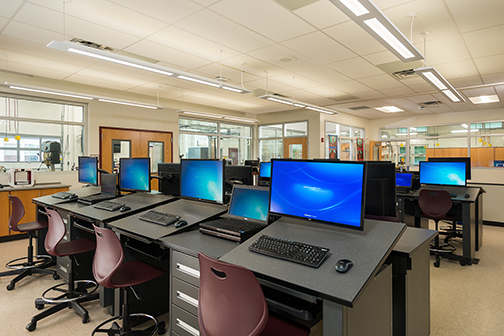
The central area of the Design & Technology Center is a 21st-century classroom that houses high-powered computers supporting Computer-aided Design (CAD) software students need to turn their ideas into designs. From there, students’ ideas spring into existence in the surrounding manufacturing rooms: the STEAM Fabrication Lab, the Materials Processing Lab, and the Computer Numeric Controlled (CNC) Lab. These modern-day labs are well-lit, well-ventilated open spaces that have essentially replaced the school’s antiquated wood and metal shops.
“The physical space of the technology labs is dynamic and flexible, which makes it conducive to creativity, innovation, and fabrication,” says Science and Technology Education Supervisor David Collins.
The Center, as a whole, is where students learn about the engineering and manufacturing process, which is how products move through the design phase (idea development, sketch, CAD, prototype, testing) to production and delivery (manufacturing, packaging, delivering, marketing).
BH-BL’s future engineers, builders, designers, welders, technicians, robotics programmers, craftsmen, etc. will collaborate with peers and teachers to experience multiple facets of their field of study and learn a variety of relevant skills and competencies that will better prepare them for their next steps, whether it’s college or a career.
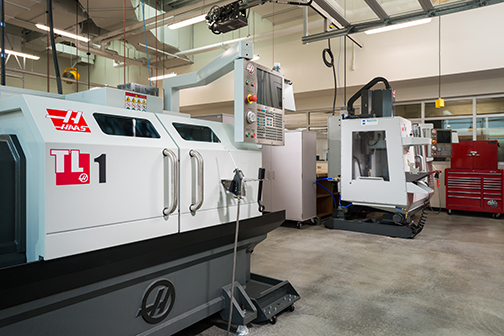
Students will also have the opportunity to use the Center’s latest equipment and technology, which is typically only seen in college-level labs and industry-caliber work environments. They’ll explore different materials and learn to use a variety of machines required to create their product. Many of the school’s outdated pieces of equipment were upgraded or replaced with Computer Numeric Controlled (CNC) machines. CNC machines are electro-mechanical devices that manipulate machine shop tools such as mills, routers, lathes, and grinders, using computer programming inputs.
“One of our main goals is to have students become highly knowledgeable about advanced technology and machinery so that the transition from high school to college or technical programs or careers is seamless,” says Collins. “And our new cutting-edge Design & Technology Center will do just that. Our students will be working on machines that most other high school students won’t see until later in their studies or careers.”
What machines and technology will students use?
In the STEAM Fabrication Lab, students will have access to a variety of brand-new, bench-top machines including a mini mill and lathe, a laser engraver/cutter, and 3-D printers and scanners. These items, along with traditional tools, will aid in the creation of various projects typically associated with the study of robotics and mechanical systems, for instance.
In the CNC and Materials Processing Labs, students will experiment with a full complement of larger CNC and manual machines and equipment. They’ll have access to such metal and wood-working equipment as cutting, milling,
and crafting machines as well as welding equipment, including virtual welding stations, CNC routers, and more. Students will use these machines to craft larger-scale projects.
“Eventually, we’d like to create capstone courses that blend multiple areas of study and require students with different skill sets to work together—much like the real world,” explains Collins.
Knowing this, can you now visualize the artist who brings his furniture design to an engineer who moves the idea from paper to production by working with a technician who operates the machines to manufacture the furniture that will be marketed and sold? You likely can, and our students will be able to as well.
Sophisticated art classrooms support collaboration, creativity
With nearly 450 high school students taking one or more of the 19 art courses offered, it’s really no wonder that BH-BL modified STEM (the more commonly known education acronym) to include Arts, thus becoming STEAM—Science, Technology, Engineering, Arts, and Math.
“Arts play an integral role in education as a whole,” says Director of Fine Arts Peter Giroux. “And much like other academic subjects, art easily interweaves with other fields of study to enrich the cross-curricular collaboration
we encourage in our district.”
The high school’s new STEAM addition includes three high-tech art classrooms with SmartHubs and advanced instructional technology that allows for improved art demonstrations, instruction, design, and production. For example, explains Giroux, the high-definition projectors and document cameras enable teachers to display, capture, and share with the entire class real-time images of students’ artwork. This is a useful tool that can help those who might need assistance with a technique during the creation process or are seeking constructive criticism from peers.
Students also have access to unique pressure-sensitive computer monitors that allow them to manipulate and create digital artwork using their fingertips or a stylus. An added bonus is the monitors do not register the pressure generated from a student’s palm or the side of his hand when it rests on the screen. The monitors also sense that more pressure generally means a line or drawn area should have a thicker or heavier stroke, depending on the artwork being created.
The new space also allows for a larger art gallery with display areas that better reflect a real-world art setting, thus giving students a glimpse of how their artwork would look at a professional gallery. Finally, the new space is more flexible and conducive for the school’s annual Arts Festival.
“We can host our Arts Festival musical performances in the auditorium without disrupting the flow of the art show next door where spectators are encouraged to ask the artists questions and artists can share the inspiration for their artwork,” adds Giroux.
Black box theater expands opportunities for students, community
Are you ready for poetry nights, small-scale performances, and live television broadcasts? These are just a few of the events that are made possible because of the high school’s new black box theater.
A relatively new innovation in theater settings, the black box theater, includes a small performance space with black walls and a level floor designed to provide flexibility in stage and audience seating configurations.
“The less formal setting provides the means for students and staff to use the space for a variety of venues,”says English teacher Jen Summersell. “It can easily be used for everything from kinesthetic learning opportunities and movie nights for GPX and XFactor clubs to coffeehouse-style and LeFont events, to name just a few.”
The theater, which replaces the outdated lecture room (Blue Room), is outfitted with contemporary stage lighting and superior audio and video equipment. It will be used for public speaking classes where proper acoustics will help students better learn how to project their voice and enunciate. And, because the theater is equipped with a camera, students can record themselves while practicing a presentation.
Intro to Theater classes will also be held in the black box theater to give students authentic exposure to performances on a smaller, more manageable level. English classes that require students to read aloud
or act out parts of a play will also be held in the theater.
Included in the theater space will be a television production studio with a “green screen,”control booth, and monitors where students will produce and broadcast daily news and announcements, as well as video projects required for marketing classes.
Outside of the classroom, the black box theater provides an alternate location for drama club rehearsals, small workshops with visiting presenters, and in the future, events by community theater and drama groups.
“We are excited for and encouraged by the opportunities the black box theater will bring to the school and community,” says High School Principal Tim Brunson who is already looking to the future and has plans to expand course offerings to include television and movie production.
In the meantime, look for announcements on the website and Facebook and through email (SNN) about student events that will be held in the black box theater.


